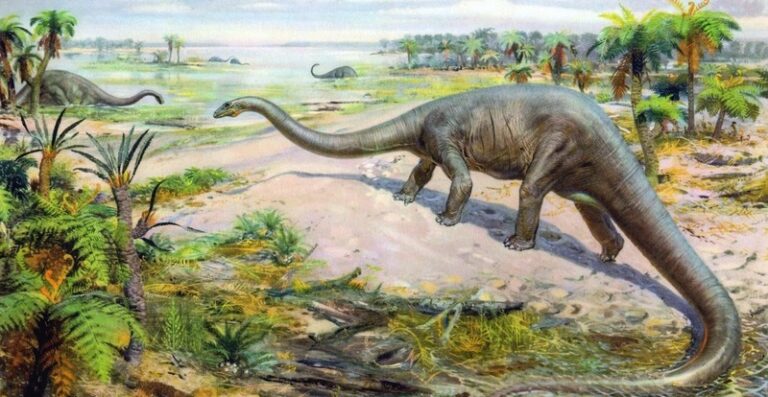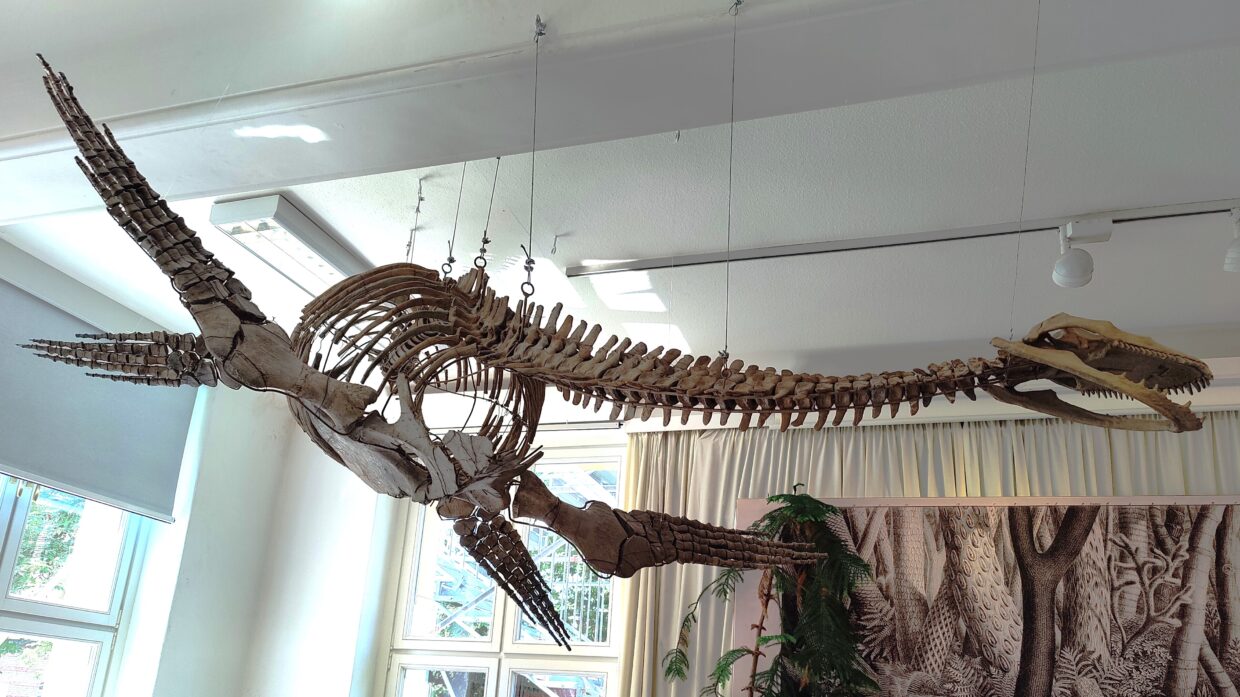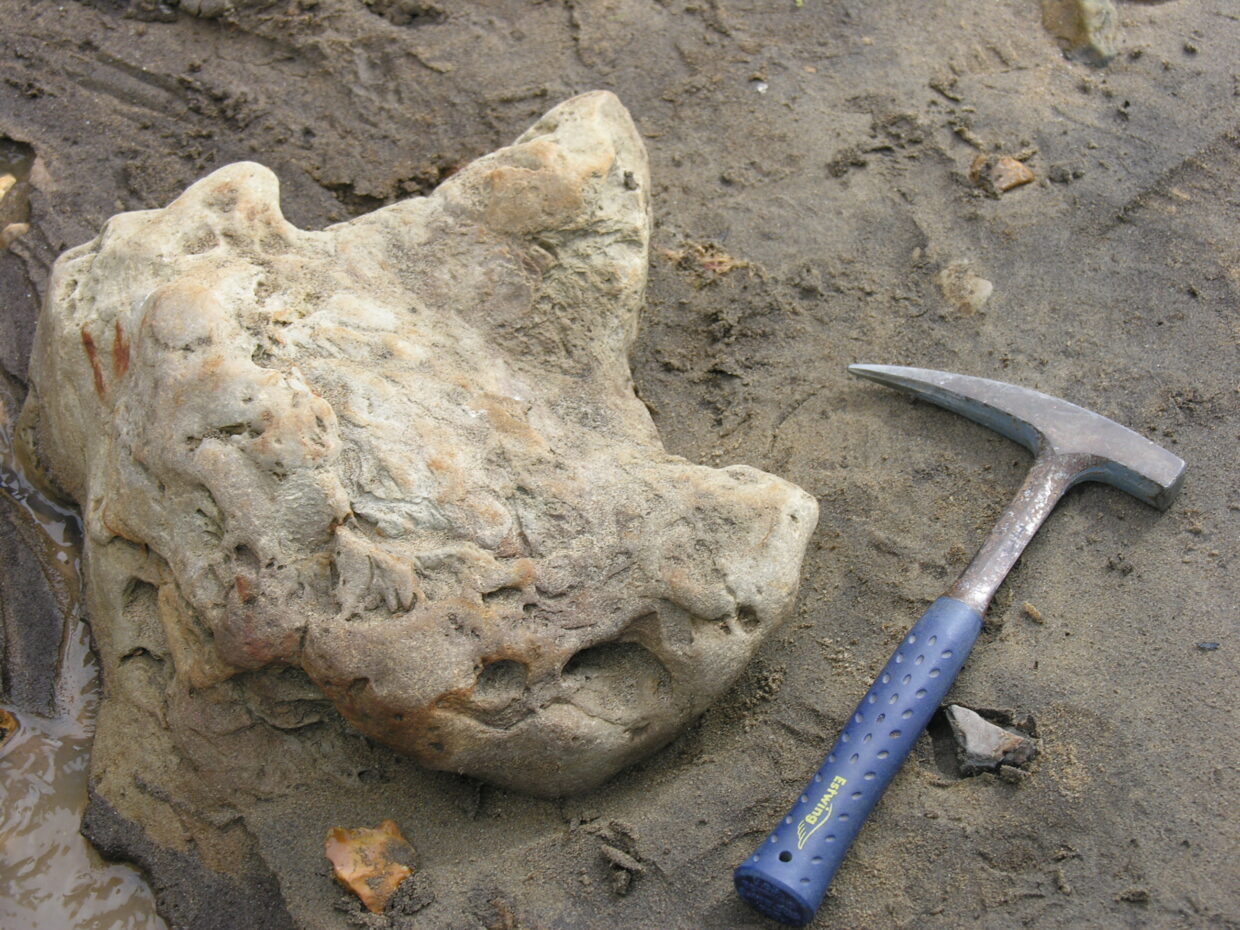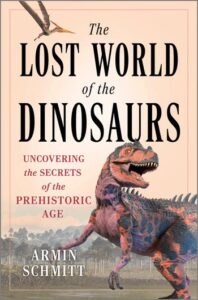The Great Dying: How Mass Extinction Made the Dinosaurs

To understand how dinosaurs became the most successful terrestrial vertebrate group in Earth’s history, we must travel to the beginnings of dinosaur evolution and clarify what factors were necessary for dinosaurs to begin their triumphant reign.
Most children today know that all dinosaurs, with the exception of modern birds, became extinct at the end of the Cretaceous period about 66 million years ago. An asteroid hit Earth at that time and sealed the fate of the dinosaurs and many other animal groups. Ammonites disappeared from the oceans. These were cephalopods related to today’s Nautilus and squids. They lived in our planet’s oceans for well over 300 million years and were an important component of complex food webs in marine ecosystems. Along with the ammonites, large marine reptiles such as the four-flippered plesiosaurs and the varanid-like mosasaurs also disappeared without any descendants.
But as terrible as this cosmic impact must have been, it is dwarfed by an event that had much greater consequences and is widely considered the worst catastrophe for life on this planet. It was a cataclysm of apocalyptic proportions, so devastating that some authors refer to it as “the Great Dying”: the Permian-Triassic mass extinction.
 Mounted plesiosaurid Cryptoclidus in Bonn, Germany, with its flippers in underwater flight posture. Photo by Armin Schmitt.
Mounted plesiosaurid Cryptoclidus in Bonn, Germany, with its flippers in underwater flight posture. Photo by Armin Schmitt.
Michael Benton, one of the most influential paleontologists of our time, wrote a book about it, giving it the striking title When Life Nearly Died. This event, which took place at the end of the Permian period, resulted in the greatest mass extinction event in the history of the Earth. About 90 percent of all species living at that time became extinct. For the first time in Earth’s history, many insect species were also affected.
During the Permian, food was still plentiful for all animals. The Earth was a green planet. For millions of years, plant growth had been so abundant throughout the world that the oxygen content in the atmosphere continued to rise and reached its highest level in the entire history of the Earth. Today, we assume that the atmospheric oxygen level was around 30 percent in the Permian. By comparison, the oxygen level in the atmosphere today is only about 21 percent.
It is perhaps an irony of fate that, on the one hand, the dinosaurs entered the world stage after a devastating mass extinction.
Droughts, fires, air pollution, and acid rain subsequently destroyed the lush forests, causing the atmospheric oxygen content to drop from 30 to about 10 to 15 percent and then remain at low levels for many millions of years. Oxygen levels would never again reach those from the beginning of the Permian. The effects were so far-reaching that it took almost 15 million years for the Earth’s forests to fully recover.
“The Great Dying,” and the subsequent collapse of the ecosystems, is thought to have been caused by mega-volcanism in Russia. The so-called Siberian traps, or flood basalts, are a testimony to this catastrophe. These are extensive lava flows that stretch from the Barents Sea in the northwest to Kazakhstan in the southwest. From there, they continue to Novosibirsk and Irkutsk in the south. In the east, they extend beyond the Lena River almost to Yakutsk. Some of you may recognize Irkutsk and Yakutsk from the board game Risk. The volcanic eruptions occurred in three spurts, over a period of about nine hundred thousand years, and covered an area of 7 million square kilometers with volcanic rock. This is equivalent to almost the entire area of Australia!
 On our quest for Jurassic dinosaurs, we drove through stunning landscapes in Chubut Province, Argentina. Photo by Armin Schmitt.
On our quest for Jurassic dinosaurs, we drove through stunning landscapes in Chubut Province, Argentina. Photo by Armin Schmitt.
The volcanic eruptions responsible for this are considered to be among the largest known volcanic events in Earth’s history. The eruptions took place about 252 million years ago at the Permian-Triassic boundary and their consequences are causally linked to the mass extinction at the end of the Permian, or “the Great Dying.” The postapocalyptic world after the Permian catastrophe must have come very close to our idea of hell. The mega-volcanism in Siberia released substantial amounts of carbon dioxide, fluorine, hydrogen chloride, and sulfur dioxide, which reacted with rain to form sulfuric acid, permanently damaging or destroying both marine and terrestrial habitats. Carbon dioxide emissions triggered global warming, increasing the global temperature by 9°F in a very short period of time. We now also suspect that the ozone layer was severely damaged by the greenhouse gases and the fly ash, resulting in an increase in UV radiation, in turn hampering plant growth and causing pollen malformations. Massive forest fires accelerated the large-scale vegetation loss, and acid rain finished off most of the plants. At that time, it only rained periodically, during the mega-monsoon season. But then, the celestial floodgates would open wide and pour forth torrents of caustic rain for days and weeks across the supercontinent of Pangaea. The rest of the year was marked by terrible heat waves, droughts, fires, and an unbearable average temperature of 113°F. While there was still sparse vegetation in the coastal regions, the interior landmass was dominated by vast deserts wider than even the Sahara or Gobi deserts. The consequences were devastating. The extreme environmental conditions increased erosion on land. This resulted in extensive draining of the soil into the sea, leading to eutrophication effects such as algal blooms in marine habitats. At the same time, there was a mass proliferation of marine protozoa in oxygen-free environments, whose metabolic products—in addition to all the gases from the massive volcanism—released methane, halocarbons, and large amounts of hydrogen sulfide (H2S) into the atmosphere.
In the meantime, anoxic—oxygen-free—conditions developed in the oceans, causing all reefs and their inhabitants to die off. Rocks that bear witness to this momentous event are called black shales, which are dark-colored organic-rich sediments. With the formation of anoxic marine zones, the rapid decrease in pH, and the release of methane hydrate, a mass extinction began in the oceans. As a result of the methane escaping into the atmosphere, the Earth’s temperature rose by a further 9°F and the upper water layers of the world’s oceans even warmed by at least 14°F. The Earth was burning and the oceans were boiling. The ever-increasing concentration of greenhouse gases led to a domino effect, which we describe as a galloping greenhouse effect, that explains why the mega-volcanism in Siberia lasted almost a million years but the mass extinction only thirty thousand. Initially, the changes were gradual, but as more and more habitats were damaged and more and more pollutants were emitted, temperatures increased faster and faster, and the collapse of the ecosystems became unstoppable. In the end, about 95 percent of all marine species and about 75 percent of all terrestrial species became extinct during this event. Among the few survivors were the direct ancestors of dinosaurs and crocodiles: the so-called archosaurs.
This thrilling journey of the dinosaurs was sandwiched between two of Earth’s greatest mass extinction events.
Without this catastrophe, the triumphant rise of the dinosaurs would probably never have happened. And so it is perhaps an irony of fate that, on the one hand, the dinosaurs entered the world stage after a devastating mass extinction, while on the other, they then fell victim to a mass extinction themselves. There have been five such events of mass extinction in the history of the Earth. Three of them are closely related to the origin of the dinosaurs and were crucial for their unprecedented evolutionary success—but ultimately also responsible for their demise:
1. The Permian catastrophe about 252 million years ago (“the Great Dying”) favored the development of the archosaurs. The archosaurs, or “ruling lizards,” include all crocodiles and dinosaurs. Birds also belong to this group, but they did not yet exist in the Triassic. The archosaurs, and dinosaurs in particular, were able to hold their own well in the hostile world of the Triassic because their efficient lungs were better able to cope with the low levels of atmospheric oxygen, they could run faster with their long, straight legs, and their bodies were farther from the hot ground than those of other lizards and amphibians. These traits were advantageous in the oftentimes desertlike regions of the prehistoric continent. This allowed them to colonize new habitats. Their scaly skin prevented their bodies from drying out, which was an invaluable advantage in the sweltering heat of the Triassic.
2. The end-Triassic mass extinction, which occurred about 201 million years ago. This catastrophe killed the conodonts in the sea, which had existed for about 340 million years and now disappeared without descendants. As either the first vertebrates, or close relatives of today’s vertebrates, they are among the earliest forms that later gave rise to fish, amphibians, reptiles, mammals, and birds. Further impacting dinosaur evolution was the extinction of four major groups of crocodilian relatives at the end of the Triassic: rauisuchians, phytosaurs, aetosaurs, and ornithosuchians. These representatives of the crocodilian lineage were similarly as successful as the dinosaurs in the Triassic. At the same time, almost all temnospondyls, a clade of giant amphibians that could grow up to thirteen feet long, became extinct. They are considered a sister group of today’s frogs and salamanders. For simplicity, they can be thought of as thirteen-footlong monster salamanders with bony plates on their skin. With the demise of the monster salamanders and most land-dwelling crocodiles, there was no longer any competition for the dinosaurs, and so they became the undisputed rulers of the Earth at the beginning of the Jurassic.
3. The end-Cretaceous mass extinction about 66 million years ago finally sealed the fate of all dinosaurs that were not true birds and not on the bird lineage. The end of this book explores why the dinosaurs did not survive the asteroid impact. The fossil record includes all scientifically documented finds of fossils worldwide. The occurrence of fossils at a certain place is usually mentioned in scientific publications. Therein, the geographical location as well as the stratigraphic context of the finds are given. Investigating, adding to, and ultimately completing the fossil record are some of the most important tasks in paleontology.
Between these three catastrophes stretched incredibly long periods of time. The evolution of the dinosaurs took place between the Permian catastrophe and the impact of the asteroid at the end of the Cretaceous period. These events are about 186 million years apart. In order to imagine such a time span, one must keep in mind that Tyrannosaurus and humans are separated by a little more than 65 million years. The last Tyrannosaurus became extinct 66 million years ago and humans (Homo sapiens) emerged about three hundred thousand years ago. Stegosaurus, on the other hand, became extinct almost 148 million years ago, so it lived about 80 million years before Tyrannosaurus. So, in terms of geologic time, these two are further apart than Tyrannosaurus and humans. But the very first dinosaurs emerged another 90 million years or so before Stegosaurus. Consequently, Plateosaurus (an ancestor of the later long-necked dinosaurs) lived in a completely different world than Stegosaurus, and Tyrannosaurus, in turn, lived in a completely different world than Stegosaurus. The reign of the dinosaurs lasted so incredibly long that entire continents broke up, seas opened and closed again, and entire oceans were created during it.
 At the south coast of the Isle of Wight, United Kingdom, natural casts of dinosaurian footprints are exposed. Photo by Armin Schmitt.
At the south coast of the Isle of Wight, United Kingdom, natural casts of dinosaurian footprints are exposed. Photo by Armin Schmitt.
This thrilling journey of the dinosaurs was sandwiched between two of Earth’s greatest mass extinction events. In both cases, these were global disasters. Why is this important? Dinosaurs were the most successful land creatures in the long history of the Earth. No other group of animals reigned on land as long as they did. Yet, at the end of the Cretaceous period, they fell victim to a mass extinction triggered by changes in climate and vegetation. While the cause of this extinction was the asteroid, it only killed a few dinosaurs directly. Countless more animals died in agony in the weeks and months following the impact, after the sky darkened, temperatures changed, forests died, and the food chain collapsed.
This scenario sounds familiar. Today, man is certainly the most successful complex organism on Earth. Just like the dinosaurs, we have colonized every continent, hold our own against every enemy, and use all of the Earth’s resources—at the same time, the fastest climate change we know of in all of Earth’s history is taking place around us, while we face unprecedented species extinctions, the scope of which cannot yet be foreseen. According to a 2019 estimate, the number of birds in North America has declined by about 3 billion since 1970, or about 30 percent of the population there. In Germany, according to the Nature and Biodiversity Conservation Union, or NABU, the number of breeding pairs of birds declined from 97.5 million in 1998 to 84.8 million in 2009, a decrease of 15 percent in just eleven years. Never before in Earth’s history have so many birds died. At the same time, the number of flying insects in Germany’s nature reserves has declined by an extremely alarming 76 percent over the past twenty-seven years. But while we might be glad that there are fewer mosquitoes at night, flying insects are the main pollinators of most crops and at the same time an important contributor to the diet of most bird species.
The causes of climate change at the end of the Cretaceous period are different than today, but that does not make the current situation any less severe. The extinction of the dinosaurs had extrinsic causes, while anthropogenic influences are responsible for our current situation. Humans themselves are driving climate change and species extinction.
I often hear that some people don’t believe in climate change, and don’t believe that humans have any significant impact on climate change. The devastating species loss we are currently experiencing makes surprisingly few headlines. Yet climate change and species extinction can be observed in nature. They can be objectively measured and proven with reproducible scientific experiments, whether you believe in them or not. Personal views and opinions are irrelevant here. And if we choose to ignore the warning signs, the problems will not go away—they will only get worse.
__________________________________

Excerpted from The Lost World of the Dinosaurs: Uncovering the Secrets of the Prehistoric Age by Armin Schmitt. Copyright © 2023 by dtv Verlagsgesellschaft mbH & Co. KG, Munich. Published by Hanover Square Press, an imprint of HarperCollins Publishers. Illustrations by Ben Rennen.
